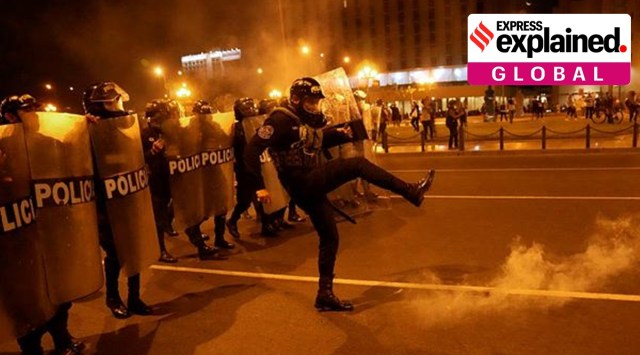Machu Picchu indefinitely shut for tourists: Why are Peruvians protesting
Protesters in Peru have blocked highways, damaged airports and set fire to buildings, prompting a violent crackdown from security forces, in which even those not protesting have been killed. Here is what is happening, and why.
 Police in riot gear move to confront anti-government protesters during a march against President Dina Boluarte, in Lima, Peru, on January 23. (Photo: AP)
Police in riot gear move to confront anti-government protesters during a march against President Dina Boluarte, in Lima, Peru, on January 23. (Photo: AP)As protests rage in Peru, the popular tourist destination of Machu Picchu has been indefinitely shut for visitors. According to Reuters, 46 people have been killed in the protests, on since December last year. On January 19, over 400 tourists were left stranded at the foot of Machu Picchu after protesters damaged trains to the 15th-century Inca fort. The 148 foreigners and 270 Peruvians were evacuated to safety only by January 21.
Peru’s economy is heavily dependent on tourism, and Machu Picchu – described by UNESCO as “among the greatest artistic, architectural and land use achievements anywhere and the most significant tangible legacy of the Inca civilisation” – alone attracts over a million visitors per year.
 Machu Picchu attracts over a million visitors per year. (Photo: Wikimedia Commons)
Machu Picchu attracts over a million visitors per year. (Photo: Wikimedia Commons)
The protests have also led to the one of the largest mines in the country suspend operations. Glencore’s Antapaccay copper mine, located in Cusco, the gateway to Machu Picchu, was Friday attacked for the third time this month. In capital Lima, the National University of San Marcos was stormed by the protesters, leading to a backlash from security personnel and the arrest of 200 people.
According to Reuters, protesters have blocked highways, damaged airports and set fire to buildings, prompting a violent crackdown from security forces, in which even those not protesting have been killed.
On January 10, Peru’s top prosecutor’s office launched an inquiry against President Dina Boluarte and her cabinet over the clashes with demonstrators.
Why are Peruvians so angry?
Peru has seen on-and-off protests since early 2022, when a motion to impeach then President Pedro Castillo failed. However, the protests escalated dramatically in December, after Castillo was unseated and arrested. Castillo was succeeded by Dina Boluarte, Peru’s first woman president, who was immediately greeted with demands of removal. While she announced that elections would be moved up to 2024 from the scheduled 2026, that failed to assuage protesters. Her government’s violent crackdown on the demonstrators and imposition of emergency in several areas have since worsened matters.
While Castillo was removed amid allegations of corruption and an attempted coup, he remains popular among sections, specially the rural masses, who view Lima’s elite as corrupt and disconnected from their concerns. Castillo is only the second President of Peru born outside Lima, since 1956.
Long time in the making
While protests have been seen across Peru, the worst of the violence has been reported from the long marginalised, left-leaning south, also the country’s tourism hub. For a long time, the largely indigenous region has been at odds with the political centre of the country, dominated by descendants of colonial settlers.
Peru has been in a churn, amid political uncertainty coupled with economic hardships worsened by Covid-19. On top of this, the Russia Ukraine war ushered in massive inflation, in a country heavily dependent on oil imports.
Castillo’s rise came in the context of these issues – his political message of “No more poor people in a rich country” resonated with the masses. However, his tumultuous tenure and subsequent ouster has left a vacuum. While Peruvians want change, Castillo’s political opponents – the big-business-friendly right wing – are unpopular. Boluarte, a Castillo ally who fell out with him, is not seen as a legitimate President by many, and the protesters are calling for fresh elections.
Castillo’s rise and fall
Castillo, 53, was born to illiterate farmers in rural Peru. He became a teacher and was an active Union leader, organising for better pay and working conditions. His 2021 presidential campaign carried forward his socialist roots, promising to improve his country’s economy and reduce its chronic inequality.
However, partially due to his own shortcomings and partially due to systemic dysfunction, his tenure failed to live up to expectations. He was embroiled in several corruption allegations, tried to suspend Congress after impeachment attempts, but found no support. According to a report in The Guardian, after his failed coup, Castillo tried to seek asylum in the Mexican embassy, but his own security detail diverted his car to a police station.
- 01
- 02
- 03
- 04
- 05






































